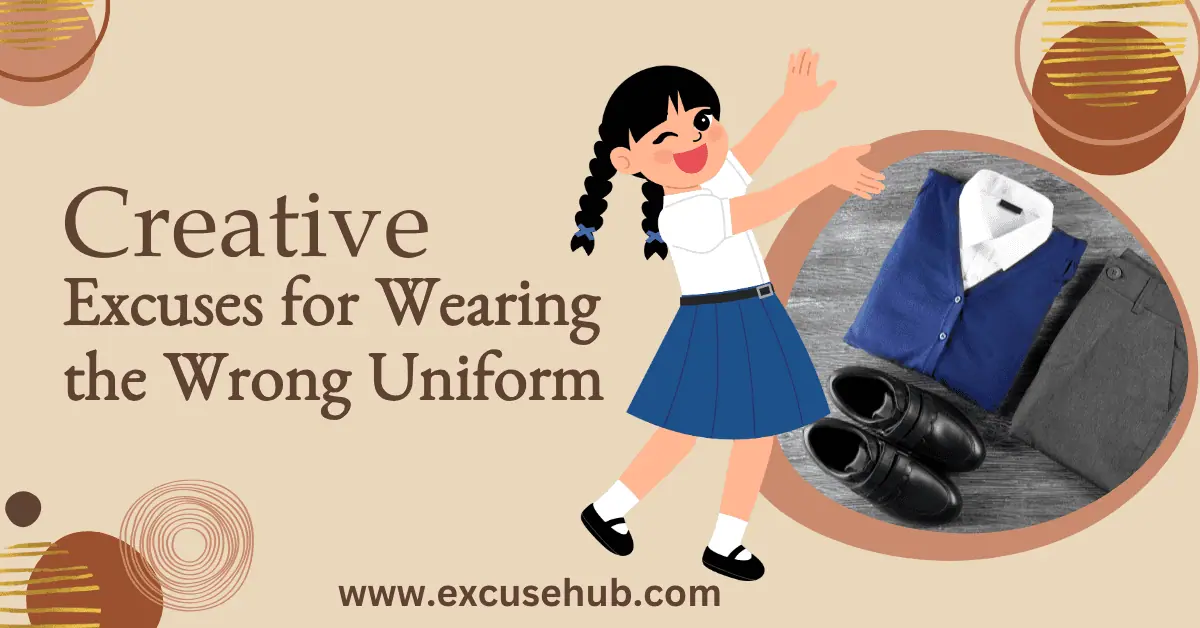Creative Excuses for Wearing the Wrong Uniform
You might find yourself needing an excuses for wearing the wrong uniform due to various unexpected factors. Laundry day disasters can result in ruined attire, while last-minute shift changes often necessitate hasty uniform adjustments. Closet confusion can also lead to unintended mix-ups, especially if your wardrobe lacks organization.
Misunderstandings about dress codes or unforeseen weather changes can further complicate your attire choices. Accidental costume days and borrowed attire blunders add to the list of potential mishaps. Each situation highlights the importance of preparation and awareness regarding uniform expectations, and there’s more to explore about managing these challenges effectively.
Key Takeaways
- A last-minute shift change forced me to grab a different uniform quickly, leading to the mix-up.
- I mistakenly misinterpreted the dress code for today’s event, resulting in wearing the wrong attire.
- An unexpected laundry mishap left my primary uniform unwearable, so I had to improvise with what was available.
- I was unprepared for a sudden team substitution and couldn’t change into the correct uniform in time.
- Communication errors regarding themed days led to me wearing an inappropriate outfit for the occasion.
Laundry Day Disaster
On laundry day, unexpected mishaps, like a sudden bleach spill, can easily lead to the unfortunate mistake of wearing the wrong uniform to school. Such incidents exemplify how laundry chaos can disrupt your routine, forcing you to scramble for alternatives at the last minute.
You might find yourself staring at a favorite shirt, now faded beyond recognition, the result of a detergent disaster that occurred when you overloaded the washer or mixed incompatible products. These are not just trivial issues; they are good excuses for not wearing the proper school uniform.
The implications of these laundry mishaps extend beyond mere aesthetics; they can impact your confidence and performance. Wearing an outfit that doesn’t align with your school dress code can lead to feelings of embarrassment, undermining your professionalism. Furthermore, the unpredictability of laundry day underscores the necessity of planning ahead.
To mitigate these risks, consider establishing a more structured laundry schedule. Designating specific days for washing your school uniform can help minimize the likelihood of chaos. Additionally, keeping an inventory of your uniforms can guarantee you have backups ready in case of mishaps.
By taking these proactive steps, you can avoid the pitfalls associated with laundry day disasters and maintain the integrity of your professional image, ensuring you are always prepared and in compliance with your school uniform policy.
Last-Minute Mix-Up
When faced with an unexpected schedule change, your uniform choice may become a hasty decision rather than a deliberate one.
The previous laundry day disaster can exacerbate this situation, leaving you with limited options in the moment.
Understanding how these last-minute mix-ups occur is essential to prevent them in the future.
Unexpected Schedule Change
A sudden shift in your schedule can easily lead to a last-minute mix-up, leaving you in the wrong uniform without any prior warning.
Schedule surprises can disrupt your routine, compelling you to make last-minute adjustments that may not align with your expectations. Understanding the implications of such unexpected changes is essential for maintaining professionalism.
Consider these common scenarios that can lead to wearing the wrong uniform:
- Shift Changes: You receive a text or email notifying you of an immediate shift change, requiring you to adjust your plans.
- Team Substitutions: A teammate unexpectedly falls ill, and you’re asked to step in, leaving little time to prepare.
- Last-Minute Meetings: An urgent meeting is scheduled, and you’re unaware of the uniform expectations for that occasion.
- Travel Delays: You encounter unexpected traffic or other delays that prevent you from changing into the correct attire.
Laundry Day Disaster
Laundry day can quickly turn into a disaster, especially if you find yourself scrambling to meet uniform standards without clean attire on hand. A laundry mishap can lead to the unintentional wearing of the wrong uniform, and the consequences can be significant. Perhaps you mistook the detergent for a fabric softener, resulting in a detergent disaster that left your clothes unfit for wear.
To illustrate the potential pitfalls of a laundry day gone wrong, consider the following table:
| Scenario | Outcome |
|---|---|
| Wrong detergent used | Clothes remain stained |
| Forgotten load | No clean uniforms available |
| Mixed colors | Uniforms discolored |
| Improper drying | Excessive wrinkles |
| Last-minute wash | Incomplete drying |
Being prepared can mitigate these issues. Organizing your laundry schedule and maintaining a checklist of uniform requirements can help you avoid the last-minute mix-up that results from a laundry day disaster. By taking these steps, you not only guarantee compliance with uniform standards but also foster a sense of professionalism in your appearance.
Closet Confusion
Closet confusion often arises from the overwhelming variety of uniforms, leading to unintentional mix-ups and misplaced attire. When your closet isn’t organized, distinguishing between similar outfits becomes challenging, particularly under time constraints. This chaos can result in wearing the wrong uniform, which is both embarrassing and unprofessional.
To mitigate closet confusion, consider these four strategies:
- Categorize Your Uniforms: Group similar uniforms together by color or type, making it easier to locate what you need quickly.
- Implement Outfit Planning: Dedicate time each week to plan your outfits, ensuring you know exactly what to wear each day.
- Utilize Visual Aids: Hang a visual guide in your closet that indicates which uniforms correspond with specific days or events.
- Regularly Declutter: Routinely assess your closet to remove unnecessary items, which helps maintain organization and clarity.
Fashion Forward Fail
When you consider your wardrobe choices, unintentional style decisions often lead to misalignments with expected uniforms.
Additionally, wardrobe malfunctions can create misunderstandings about your intended fashion statement, further complicating your appearance.
Unintentional Style Choices
Unintentional style choices often stem from a misalignment between personal expression and situational expectations, leading to fashion-forward fails that can undermine confidence. Your wardrobe personality plays a vital role in this disconnect, as it reflects your individual tastes and preferences. However, the evolution of your style may not always align with the contexts you find yourself in.
Consider these common scenarios where unintentional style choices can occur:
- Event Misunderstanding: Dressing too casually or formally for an occasion can result in discomfort and self-consciousness.
- Trend Overload: Following trends blindly without considering your unique style may lead to an outfit that feels inauthentic.
- Seasonal Confusion: Wearing fabrics or colors that don’t match the season can clash with the environment, affecting your overall look.
- Improper Fit: Choosing clothes that don’t fit well can detract from your appearance, regardless of your intent to showcase your wardrobe personality.
Recognizing these pitfalls is essential for steering your style evolution effectively. By aligning your personal expression with situational expectations, you can avoid the missteps that lead to unintentional fashion failures.
Wardrobe Malfunction Misunderstandings
Wardrobe malfunctions often arise from misunderstandings about fit, fabric, and function, transforming a fashion-forward outfit into a source of embarrassment. You might believe your ensemble is cutting-edge, yet a miscalculation regarding any of these elements can lead to a noticeable style faux pas.
To illustrate, consider the following table:
| Factor | Potential Issue |
|---|---|
| Fit | Too tight or too loose |
| Fabric | Inadequate stretch or breathability |
| Function | Inappropriate for occasion |
| Maintenance | Requires special care |
When your attire doesn’t fit properly, it can lead to uncomfortable tugging or gaps that undermine your overall look. Likewise, selecting the wrong fabric can result in unsightly bunching or transparency, both of which can be perceived as a wardrobe malfunction. Additionally, not considering the function of your outfit can set you up for unexpected challenges, such as wearing heels to an outdoor event.
Seasonal Fashion Trends
Seasonal fashion trends often lead individuals to experiment with bold styles that may ultimately clash with their personal aesthetics, resulting in a fashion-forward fail. As you navigate the complexities of style, it’s important to align your choices with your own preferences rather than succumbing to fleeting trends.
Here are four common pitfalls to avoid:
- Ignoring Color Palettes: Seasonal color palettes can be enticing, but not every shade suits you. It’s vital to choose colors that complement your complexion.
- Chasing Fabric Trends: While certain materials may be in vogue, they mightn’t align with your lifestyle or comfort. Don’t sacrifice comfort for the sake of trends.
- Overdoing Accessories: With bold fashion trends, it’s easy to overwhelm your outfit with accessories. Aim for balance to avoid a cluttered appearance.
- Fitting into the Wrong Silhouette: Each season may present new shapes and cuts, but not all will flatter your figure. Select silhouettes that enhance your best features.
Dress Code Ignorance
On laundry day, unexpected mishaps, like a sudden bleach spill, can easily lead to the unfortunate mistake of wearing the wrong uniform to school. Such incidents exemplify how laundry chaos can disrupt your routine, forcing you to scramble for alternatives at the last minute.
When you fail to understand the specifics of a school uniform policy, it can easily lead to misconceptions and ultimately result in wearing the wrong uniform. Dress code clarity is vital to ensure adherence to the established uniform agenda. Without this clarity, individuals might misinterpret guidelines, assuming that casual attire or alternative styles are acceptable.
This lack of understanding often stems from vague or poorly communicated dress codes. If policies aren’t explicitly stated, you might find yourself guessing what’s appropriate, which can lead to unintended violations. For instance, if the uniform policy specifies colors or styles that aren’t clearly defined, you might unknowingly choose an outfit that doesn’t comply.
You might find yourself staring at a favorite shirt, now faded beyond recognition, the result of a detergent disaster that occurred when you overloaded the washer or mixed incompatible products. These are not just trivial issues; they are good excuses for not wearing the proper school uniform.
Furthermore, differing interpretations of dress code rules among peers can create confusion. If you observe others wearing varied uniforms, you may assume that deviations are permissible, further complicating the situation.
To avoid these pitfalls, it’s important to establish a more structured laundry schedule and seek clarification when in doubt. Designating specific days for washing your school uniform and keeping an inventory of your uniforms can help minimize chaos.
Additionally, regularly reviewing the uniform policy can guarantee adherence to the guidelines, thereby minimizing the chances of wearing the wrong uniform and maintaining a professional appearance.
Accidental Costume Day
Misunderstandings surrounding dress codes can lead to unexpected situations, such as accidentally showing up in costume for an event that wasn’t intended to be themed. These occurrences, while often embarrassing, reveal the nuances of costume creativity and the potential for playful mishaps in social settings.
Here are four common scenarios that might lead to an Accidental Costume Day:
- Misinterpreted Invitations: You might overlook subtle cues in an event’s invitation, leading you to believe that costumes are encouraged when they’re not.
- Themed Days Miscommunication: Workplaces or schools may have themed days that aren’t widely communicated, resulting in mismatched attire.
- Last-Minute Changes: Event planners might switch themes at the last moment, leaving attendees unaware of the new dress code.
- Social Media Influence: Trends on social media might prompt you to dress in a specific way, regardless of the actual event’s requirements.
In these cases, while you may feel out of place, such playful mishaps can foster camaraderie and acceptance, transforming potential embarrassment into memorable interactions and showcasing your unique take on costume creativity.
Borrowed Attire Blunder
Borrowing attire can lead to unexpected mismatches, particularly if the borrowed item doesn’t align with the event’s intended dress code. This scenario highlights the significance of attire etiquette, as misjudgments can result in unintentional faux pas.
When you borrow clothing, you might feel a sense of borrowed confidence, believing that the new outfit will elevate your appearance. However, this confidence can quickly dissipate if the attire fails to meet the context of the occasion.
For example, if you borrow formal wear for a casual gathering, you risk looking out of place, which can undermine your confidence and impact your interactions. It’s essential to assess not only the fit but also the appropriateness of the borrowed item. Engaging in attire etiquette means considering the event’s atmosphere and the expectations of your peers.
To avoid the borrowed attire blunder, communicate openly with the lender about the intended use of the clothing. This guarantees that both parties are aligned on the appropriateness of the outfit.
Seasonal Slip-Up
A common challenge arises during seasonal changes, where individuals often misjudge the appropriate attire for varying weather conditions and events. This miscalculation can lead to a significant fashion faux pas, particularly when shifting between seasons. Your seasonal wardrobe may not always align with the occasion, and these missteps can be both uncomfortable and socially awkward.
Here are four common seasonal slip-ups to avoid:
- Dressing Too Light: Wearing summer clothing during early fall can leave you feeling chilly and out of place.
- Overdressing: Conversely, bundling up excessively in winter attire during a mild day can lead to discomfort and embarrassment.
- Ignoring Footwear: Changing seasons often requires a change in footwear; sandals in fall can signal a lack of preparedness.
- Misjudging Fabrics: Lightweight fabrics may not provide enough warmth in shifting weather, making you appear ill-suited for the season.
Unexpected Weather Change
Unexpected weather changes can disrupt even the most carefully planned outfits, leaving you scrambling to adapt to conditions that weren’t anticipated. When faced with an unexpected temperature drop or sudden rain, you might find yourself out of uniform. This situation underscores the importance of weather preparedness tips, which can greatly enhance your adaptability.
To mitigate the impact of unforeseen weather shifts, consider implementing climate adaptability strategies. Layering your clothing allows for flexibility; you can easily add or remove garments based on the temperature. Additionally, investing in versatile pieces that suit various conditions, such as moisture-wicking fabrics or quick-dry materials, can prove invaluable.
Monitoring weather forecasts regularly is another vital aspect of preparedness. By staying informed about potential changes, you can make proactive wardrobe choices. Carrying compact, portable accessories like foldable umbrellas or lightweight jackets can further guarantee that you’re equipped for any sudden changes.
Conclusion
In the grand tapestry of workplace attire, your missteps stand as reflections of the chaos of modern life. Laundry disasters and unexpected weather shifts are merely the tip of the iceberg, revealing how easily the line between professionalism and sartorial faux pas blurs.
As you navigate the fine print of dress codes and accidental costume days, remember that excuses for wearing the wrong uniform can turn fashion failures into bold statements. After all, who needs uniforms when you can make a memorable impression with a touch of creativity?
Frequently Asked Questions
How Do I Explain My Uniform Mistake to My Supervisor?
When addressing your uniform mistake, prioritize clear communication with your supervisor. Acknowledge the error, reference the uniform policy, and express your commitment to adhering to guidelines in the future to foster understanding and trust.
Can I Wear My Regular Clothes Instead of the Uniform?
While casual attire symbolizes individuality, it often clashes with established dress codes. You can’t wear regular clothes unless permitted; it is crucial to respect the uniformity and professionalism your organization’s dress code aims to maintain.
What Are the Consequences of Wearing the Wrong Uniform?
Wearing the wrong uniform can lead to punctuality issues, as it may delay your readiness. Additionally, it negatively impacts team morale, creating discrepancies in appearance that may undermine unity and professionalism within the group.
How Can I Avoid Uniform Mix-Ups in the Future?
To sidestep wardrobe mishaps, implement uniform organization tips like dedicated storage spaces and color-coding. Additionally, adopt personal wardrobe strategies such as creating a checklist, ensuring your attire aligns with specific requirements and occasions.
Is It Acceptable to Wear a Uniform From a Different Department?
Wearing a uniform from a different department often contradicts department policies and uniform guidelines. It’s essential to understand your organization’s specific regulations to maintain professionalism and adhere to established standards within your workplace.







